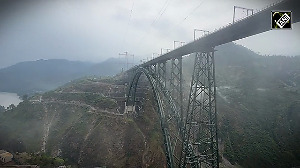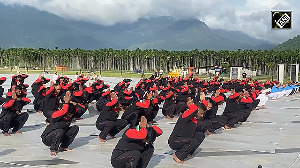 Radio Days, an award-winning 1987 film directed by Woody Allen, looks back on American family life during the golden age of radio.
Radio Days, an award-winning 1987 film directed by Woody Allen, looks back on American family life during the golden age of radio.
The narrator (Woody Allen himself) tells us how the radio influenced him in the days before TV. Each member of the narrator's family finds in radio shows an escape from reality through the gossip of celebrities, sports legends of the day, crooners, etc.
Woody Allen isn't alone. For many like him, that golden age of radio is only in the dark alleys of nostalgia.
But the good news is that there are some early signs of an increasing number of people getting hooked to their favourite radio shows once again. And India Inc has been quick to spot the opportunity of value-for-money brand promotion on radio.
Consumer durables major LG, for instance, is running extensive campaigns to promote mobile phones, air-conditioners, refrigerators and micro-ovens through radio advertisements.
L K Gupta, chief marketing officer, LG, says the medium has evolved substantially in the last three to four years both in terms of engagement as well as reach to more cities.
It provides room for customizing messages for brand-building which serves to connect better with consumers at the local level.
A spokesperson from Samsung agrees that radio gives good recall to advertisers as a support medium to television and print.
"Brands attempting to improvise jingles tend to have higher return on investment on radio than on any other media. For all our campaigns involving consumer participation we prefer using the radio as it has an immediate impact," he says
Samsung advertised on radio widely to encourage consumer participation in nominating torch bearers for the Beijing Olympics in 2008. Since then the company has increased ad-spends on radio significantly.
It is not only out-of-the-jar advertising campaigns which vie for listeners' attention on radio channels these days. In a unique radio activation module formulated by Pepsico India recently, youngsters were invited to participate in creating the 'Youngistan ka Wow' anthem with musical duo Vishal and Shekhar in the span of a day.
Sandeep Singh Arora, executive vice president marketing (Cola), Pepsico India, says, "While television gives you great reach, it is only radio which provides the flexibility to interact and co-create with listeners. The 'Youngistan ka Wow' anthem campaign was run across 23 cities in the country."
Radio also allows advertisers to reach out to a specific target group without having to purchase media space on a national scale. The low investment required has further spurred advertisers' interest in the medium. LG's Gupta says,
"While the cost per thousand reach for a 30 second commercial on television is around Rs 2000, for radio it is approximately Rs 150."
Big FM, a Reliance Media World initiative, has registered a 10 per cent rise in the number of brands which advertised on the channel last year over the previous year.
Praveen Malhotra, senior vice president sales, Big FM, says, "We are seeing companies across categories using radio effectively for building brands."
To cash in on the potential the sector is showing, Radio Mirchi has started offering all-round solutions to advertisers. Prashant Panday, chief executive officer, Radio Mirchi, says, "We create solutions for brands using the best tricks in the radio business. If required, we add in the on-ground and online components as well."
Radio Mirchi currently has over 5,000 brands which advertise across the network. More than 30 per cent of the business comes from retail clients.
Apart from retail advertisers, all telecom, auto, FMCG, consumer durables, media and entertainment, education, real estate and BFI (banking, finance, insurance) brands, Panday informs, spend heavily on radio.
However, everyone agrees radio still has a long way to go. Ashish Pherwani, associate director, media and entertainment, at Ernst and Young, says the advertising revenue of the radio industry at Rs 800 crore (Rs 8 billion) is just 3.5 per cent of the total advertising pie and saw flat growth in the previous two financial years due to the economic slowdown.
But things are changing and he expects the industry to grow by roughly 10 per cent in the current financial year.
A lot, however, will depend on the third phase of the FM privatisation policy and whether it permits players to bid for multiple frequencies/licences in metros, he adds.











